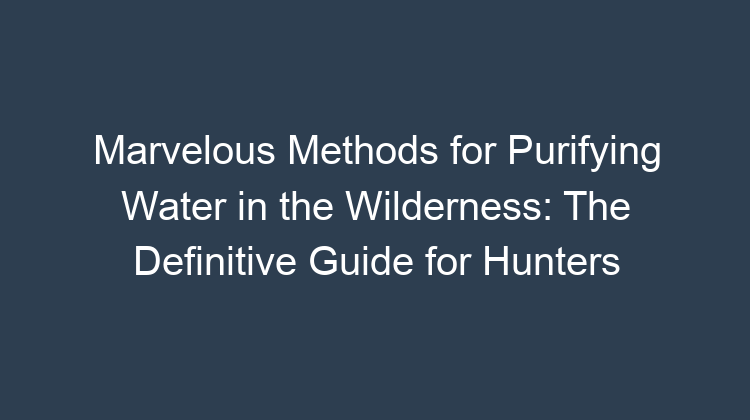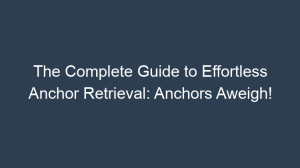Hunter education courses prioritize not just marksmanship but also survival skills, including water purification. Clean water is crucial for hunters traversing the untamed wilderness. Untreated water from natural sources often harbors micro-organisms or contaminants that can lead to illness. Being prepared with water purification methods during hunting expeditions safeguards your health.
Wilderness water purification techniques vary in complexity and efficiency. From primitive boiling techniques to advanced filtration systems, explorers have several options. The key lies in understanding each technique’s suitability for specific conditions and resources.
Embracing the responsibility of being an informed hunter also extends to obtaining and maintaining proper water purification equipment. Knowledge regarding the different techniques and their applications equips you to confidently tackle any water purification challenge encountered during your hunting pursuits. So, step forward with fortitude, secure in the knowledge that you possess the skills and tools to transform tainted water into the elixir of life.
Boiling: Nature’s Timeless Technique
Simplicity and Effectiveness
Boiling water remains a classic method to destroy waterborne pathogens. The simplicity of this technique makes it accessible to hunters in any location. To effectively eliminate bacteria and viruses, ensure water reaches a rolling boil for at least one minute.
Handling Turbid Water
Turbid water, laden with sediments or particles, may not always respond well to boiling alone. To enhance the efficiency of purification, consider pretreating the water using a cloth or paper filter. This filtration step removes particles that can hinder the boiling process, ensuring a more thorough disinfection.
Limitations and Practicalities
Boiling water, while effective, has a few limitations. Fuel and time constraints may not favor prolonged boiling in certain scenarios. Additionally, boiled water tends to taste flat and unpalatable. Packing flavor additives or a water purification straw can enhance the taste and negate any lingering doubts about the water’s potability.
Filtration: A Multifaceted Approach
Mechanical Microfiltration
Mechanical microfiltration systems employ a physical barrier to remove microorganisms and contaminants. These systems, ranging from simple membrane filters to sophisticated portable units, offer varying levels of filtration. Carefully select a filter appropriate for your needs and ensure proper maintenance to guarantee its effectiveness.
Chemical Disinfection
Chemical disinfection tablets or drops utilize substances like iodine, chlorine dioxide, or chlorine to inactivate harmful microorganisms. These compact and lightweight options are popular among backpackers and hunters. It’s crucial to follow the manufacturer’s instructions precisely, as incorrect dosage or improper use can compromise the purification process.
Ultraviolet Disinfection: Harnessing Light’s Power
Ultraviolet (UV) disinfection systems employ ultraviolet light to neutralize microorganisms. UV pens or wands are lightweight and easy to use. Note that UV disinfection is highly dependent on water clarity. Turbid water can shield microorganisms from UV light, reducing its effectiveness. Pretreating turbid water with a filter or allowing it to settle before disinfection is recommended.
Additional Tips for Water Purification
Inspect Water Sources
Prioritize selecting clear, fast-flowing water sources. Avoid stagnant or murky water, as they’re more likely to harbor contaminants and microorganisms.
Store Purified Water Properly
Once you’ve purified water, store it in clean and airtight containers. Proper storage prevents recontamination and ensures the water remains safe for consumption.
Educate Yourself Continuously
As technology advances, new and improved water purification methods emerge. Stay updated on these advancements to make informed choices based on your needs and preferences.
FAQ
How Do I Know When Water Is Safe to Drink?
Purified water should be clear, odorless, and free from any unusual taste. Trust your senses, and if something seems off, it’s safer to purify the water again or seek an alternative source.
Can I Purify Water Using a Plastic Bottle?
While boiling water in a plastic bottle is generally safe, it’s essential to ensure the plastic is BPA-free and can withstand high temperatures. Repeated use of the same plastic bottle for boiling water is not recommended due to potential chemical leaching.
What’s the Best Way to Purify Water If I’m Lost in the Woods?
In such situations, boiling water is your best bet. It’s a simple and effective method that requires minimal resources. If you don’t have fuel or a pot, consider creating a solar still using a plastic sheet and a container to collect distilled water.
Is It Safe to Drink Purified Water Over Time?
Purified water is generally safe for long-term consumption. However, the storage conditions and the purification method used can impact its safety over time. Always store purified water properly, and if you suspect contamination, purify it again or seek an alternative source.
What Are Some Common Mistakes to Avoid When Purifying Water?
Common mistakes include improper use of purification tablets or drops, inadequate boiling time, and neglecting to pretreat turbid water before UV disinfection. Additionally, relying on a single purification method may not be as effective as using a combination of methods. Diversifying your approach enhances the chances of obtaining safe drinking water.
Conclusion
The ability to purify water in the wilderness is an invaluable skill for hunters. By understanding the various methods available and their suitability for different conditions, you empower yourself with the knowledge to transform potentially unsafe water into a life-sustaining resource. Embrace the opportunity to learn and practice these techniques, ensuring your hunting expeditions are safe, enjoyable, and successful.







